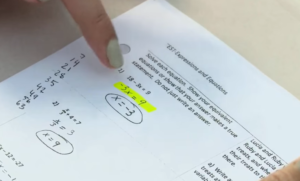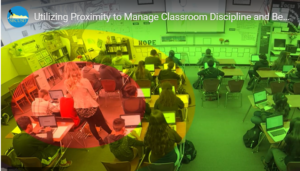Part 5: Shifting from “I Don’t Know” to “I Can Figure It Out”
Parent Pedagogy 101 is focused on sharing how the skills used by master teachers in their classrooms can also be used by parents to support learning from home. These skills include asking questions to guide learning, highlighting mistakes as part of the learning process, applying sufficient wait time, and using proximity to your advantage. Throughout my 10 years of teaching, these were my go-tos, the skills that helped keep my classroom running. Each of these techniques can be used individually, but when put in play together they can build confidence in your child and provide the next steps needed to move beyond “I don’t know” to “I can figure it out.”
1) Help build a list of questions for your child to use when they are working on their own.
In Part 1: Don’t Answer Questions, Ask Them, we shared how teachers use questions to guide students and help connect what they are working on now with other topics they’ve learned in the past. So whether your child is looking at an assignment from their teacher or completing work online, remember to ask questions – a lot of questions. If your child responds with “I don’t know,” don’t worry. Keep in mind that this is normal and happens to everyone. Try to stay positive and skip the frustrated facial expressions or disappointed tone of voice. Children say “I don’t know” for a number of reasons, including feeling pressured to say the right answer or nervous about saying the wrong answer – or it could just be they don’t remember at the moment. When at home, try asking questions like:
- What do you think?
- Really? I bet you know something.
- What do you remember?
- Could we find that information in the text?
- Where did you read about this?
- Where else could we look for the answer?
- Is there another question like this one?
- How did you do number 5?
These questions will help guide your child in the right direction and develop into a positive routine to figure it out. Going to the text or other resources is a great first step. With enough practice, your child will start asking these questions of themself and learn ways to search for the answer before saying “I don’t know.”
2) Develop an environment where your child can make mistakes.
In Part 2:  Highlighting Mistakes, we discussed how making mistakes is a crucial part of the learning process. Just because an assignment or test is graded doesn’t mean the child can move on and leave difficult material unmastered. By literally highlighting mistakes on your child’s work, instead of marking them with a X, you are providing a second chance without the judgment of it being wrong. Taking a second look by themself might be all your child needs to correct the mistake. If not, ask a few why, how, and what questions to help guide your child to a correct or more thorough answer. In most cases, it’s not that your child didn’t know the answer, just that they need a little boost to figure it out.
Highlighting Mistakes, we discussed how making mistakes is a crucial part of the learning process. Just because an assignment or test is graded doesn’t mean the child can move on and leave difficult material unmastered. By literally highlighting mistakes on your child’s work, instead of marking them with a X, you are providing a second chance without the judgment of it being wrong. Taking a second look by themself might be all your child needs to correct the mistake. If not, ask a few why, how, and what questions to help guide your child to a correct or more thorough answer. In most cases, it’s not that your child didn’t know the answer, just that they need a little boost to figure it out.
By analyzing their work, children can also learn to skip the frustration and move on after a mistake happens. This opens up room to celebrate their learning, even in correcting a mistake (“I get it now!”), instead of emphasizing how many mistakes they made (“I only got 6 right. I don’t get any of this!”). By having their progress acknowledged, children develop confidence and an understanding that mistakes are normal – even parents and teachers make them.
3) Provide time for your child to think through their answers or response.
A common reason for students to say “I don’t know” is the lack of wait time and feeling pressured to answer immediately. No one wants to look like they don’t know the answer, even if they are talking with their mom, so provide your child with a good amount of wait time to think through what you are asking. In Part 3: The Power of Wait Time, we shared that waiting 5 to 10 seconds after asking a question is a great habit to get into.
Waiting for an answer can be challenging and feel like minutes instead of seconds, but the added time will benefit your child. They will take the 5 to 10 seconds to process the question, recall past information, and formulate a more complete answer. If you find that this isn’t doing the trick, try not to jump in with the answer. Instead, try asking questions that help them figure it out – “What do you think we can do first?” or “Is there something in the text that can help?” You can always take a break, too. Put on your child’s favorite song and dance around the kitchen, have a cartwheel competition, or walk the dog. When you come back to the material, you’ll both be refreshed and ready to go!
4) Redirect behavior without having to say a word.
With cell phones and smart watches it is easy for students to get off task, and distracted students will often answer “I don’t know” to a question because they don’t even know what the question was. In Part 4: Using Proximity To Keep Your Kids On Task, we show how proximity, how near you are to your child, can help you easily monitor and help redirect behavior without having to say a word. This behavior management skill is a favorite of teachers! Instead of calling on a student who is distracted or yelling their name from across the room, teachers will walk toward a student, allowing proximity to do the work. As the student notices the teacher coming closer, typically they will get back to work. Redirection through proximity avoids confrontation and the embarrassment of being called out for not paying attention.

Just as teachers move throughout the classroom, bringing students in and out of their red, yellow, and green zones, you can do the same at home. Your child is in the red zone if they are within a few steps of you, the yellow zone if they are in your line of sight, and the green zone if you are in a different room. Shifting in and out of each zone will help you keep an eye on the learning, allow you to ask questions, be available for your child to ask you questions, and help your child build independence.
Figuring It Out
We can’t be experts in everything, so don’t pressure yourself (just as you wouldn’t pressure your child to know everything). It’s okay to feel frustrated or upset when there have been so many changes and disruptions to our lives over the past few months. The important thing is to involve your child in the process of discovery, allowing them to take their time and make mistakes along the way. If they say “I don’t know,” try not to jump in with the answer, but guide them to it. And when you don’t know it yourself, take the time to research the topic with your child and build skills that will stay with them through adulthood. We may not have all the answers, but we do have the resources to figure it out.
Kelly Zunkiewicz is a national award-winning teacher with a decade of teaching experience. She has insight into the minds of educators and students and understands what makes great teaching happen.
